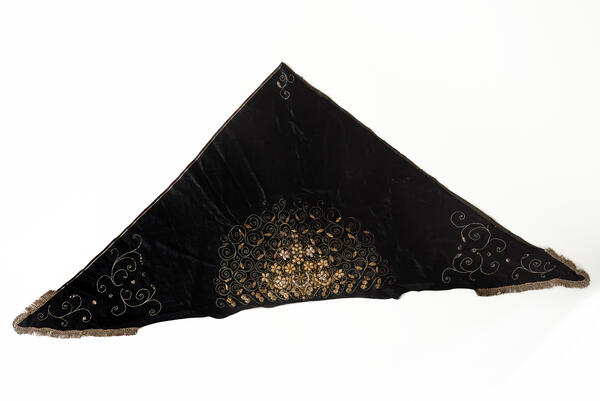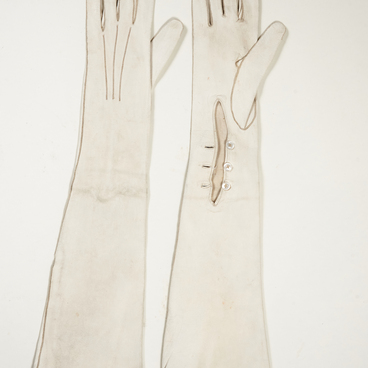The headscarf from the museum collection is a traditional female headdress with gold embroidery. It was made in Gorodets, which for a long time has been a famous center of goldwork embroidery along with Lyskovo, Arzamas, and other towns and villages of the Nizhny Novgorod governorate. Such embroidery was used for decorating shawls, sarafans (sleeveless dresses), and sleeveless jackets. A dress worn on festive occasions and embroidered with gold was the pride of the family — it was carefully preserved and passed on from mother to daughter as a family treasure.
At the end of the 18th — beginning of the 19th century, it was customary to wear a gold-embroidered kerchief together with a maiden’s band — a “povoinik” (headdress of a married Russian peasant woman) or “kokoshnik” (traditional Russian headdress). Large kerchiefs with gold embroidery could be worn in different ways. Most often, they covered the head so that its first two ends went down the back, and the other two were in the front.
The secrets of goldwork embroidery were kept very carefully in the families of Gorodets craftswomen. However, it was very difficult to save this type of clothes. The thread itself was dense and durable, but the silk, which was usually embroidered by craftswomen, would get torn or, as they used to say, “crumbled”.
Each embroidery piece required serious preparation. The thread was sewed tightly, stitch to stitch, the patterns were embroidered “on the map” — first, the shapes for each decorative element were cut out of birch bark, then they were applied to the fabric and sewed around. There was no gold embroidery on the inner side because it was usually expensive and thus put only outside. From below, the goldwork was attached with silk or linen. This technique was called couching.
Each embroidery pattern had its sacred meaning. Among the most common symbols were the tree of life, which represented the unity of a family and guaranteed its longevity and well-being; songbirds — a symbol of true love and strong family ties; grapes — an image of fertility and wealth. Maidens wore a kerchief so that the “ochelie”— the part located on the forehead — was visible, flanked by the corners of the embroidery. For the headdress to hold and not slip, tie-strings were sewn to it.
Since the middle of the 19th century, maidens of Gorodets and the nearest villages started to wear the kerchiefs with goldwork embroidery on the shoulders in such a way that the glittering pattern would not be hidden in the folds. The museum collection includes not only kerchiefs but also “povoiniks” — linen caps worn by married women. Povoniks completely covered hair, “kokoshniks”, headscarves, and other items.
At the end of the 18th — beginning of the 19th century, it was customary to wear a gold-embroidered kerchief together with a maiden’s band — a “povoinik” (headdress of a married Russian peasant woman) or “kokoshnik” (traditional Russian headdress). Large kerchiefs with gold embroidery could be worn in different ways. Most often, they covered the head so that its first two ends went down the back, and the other two were in the front.
The secrets of goldwork embroidery were kept very carefully in the families of Gorodets craftswomen. However, it was very difficult to save this type of clothes. The thread itself was dense and durable, but the silk, which was usually embroidered by craftswomen, would get torn or, as they used to say, “crumbled”.
Each embroidery piece required serious preparation. The thread was sewed tightly, stitch to stitch, the patterns were embroidered “on the map” — first, the shapes for each decorative element were cut out of birch bark, then they were applied to the fabric and sewed around. There was no gold embroidery on the inner side because it was usually expensive and thus put only outside. From below, the goldwork was attached with silk or linen. This technique was called couching.
Each embroidery pattern had its sacred meaning. Among the most common symbols were the tree of life, which represented the unity of a family and guaranteed its longevity and well-being; songbirds — a symbol of true love and strong family ties; grapes — an image of fertility and wealth. Maidens wore a kerchief so that the “ochelie”— the part located on the forehead — was visible, flanked by the corners of the embroidery. For the headdress to hold and not slip, tie-strings were sewn to it.
Since the middle of the 19th century, maidens of Gorodets and the nearest villages started to wear the kerchiefs with goldwork embroidery on the shoulders in such a way that the glittering pattern would not be hidden in the folds. The museum collection includes not only kerchiefs but also “povoiniks” — linen caps worn by married women. Povoniks completely covered hair, “kokoshniks”, headscarves, and other items.



